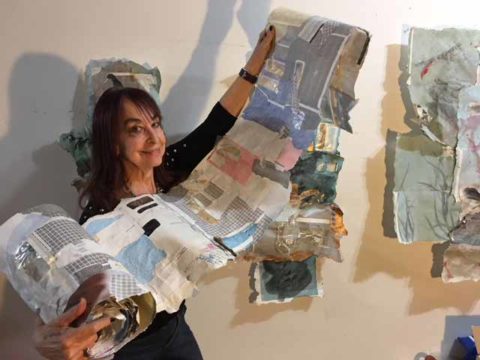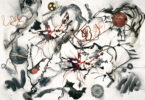Vernita N’cognita has been at it for a long time. In the case of her Endless Junkmail Scroll, she’s been at it for about 400 feet, which amounts to a football-field-and-athird. And the raw material keeps arriving every day. Nothing quite like it when art material is delivered to your door; an artist’s perverse dream, in a way. The Scroll is a highlight of a genre of work that Vernita has been pursuing for many years. She makes art from discarded materials, a genre that in modern America could never, ever be exhausted.
Vernita N’cognita is the assumed name of Vernita Nemec, New York art world denizen, who created the name to acknowledge and celebrate under-recognized artists. For every big-time artist whose work appears in museum collections, there are hundreds (if not more) who work on their own and do not receive financial or critical recognition. But that is not to say they lack artistic success. Such is the conundrum of being an artist in contemporary America.
Another dilemma of modern America is all around us, all the time. Too much stuff, and too much thrown away. Hence Vernita’s desire to use a minuscule fraction of it to create art. Her long running series of exhibitions, Art From Detritus, began in 1994. She received support initially from the National Recycling Coalition, a national organization which connects recycling programs around the country, but was not involved in the arts until she proposed it to them. Since then, the ever-evolving show, which includes the work of other artists, has been seen in museums and galleries all around the world. But the Endless Junkmail Scroll is her own baby, made from her very own junk mail; no outside contributions were necessary. It will now be shown at the Crary Gallery, in Warren, Pennsylvania in February 2018.
The Scroll began when Vernita decided that the technique of collage fit the environmental message of the ‘Detritus’ shows, and thus started to assemble it from the unsolicited paper items that came to her mailbox every day. Both envelopes and their contents are used, along with a bit of help from paints and pencil. Pieces incorporated into the collage sometimes include what is written or printed on the junk mail item. It becomes part of the statement. The Scroll has also been shown in sections rather than in it’s full length, and in a rolled form (as recently seen at the Denise Bibro Gallery in New York, where a manikin hand was placed in the center of the roll, reaching up as if desperately trying to emerge from the junk). She confessed conspiratorially that she still has boxes of junk mail stashed in her studio, for future use in the Scroll. Vernita’s own junk mail would have been thrown away and forgotten had she not elected to save it and present it as art, and thereby emphasize it not as something disposable, but something which must be remembered. Since it is made from the most common, disposable and therefore invisible materials, the Junkmail Scroll becomes a kind of chronicle of disposability. We must remember that during most of the past, there was no such thing as ‘disposable.’ Before such modern excess, things were made to last, or at least be re-used. Perhaps then, the Scroll also becomes a history of usefulness. Her ‘Philosophy of Junk’ is that junk, in general, retains it’s beauty even after it is discarded, and this alone is the justification to keep it and make it into art. And also, more idealistically, she has said that making art from junk is a step toward a collective solution to a collective problem that would never have happened if all of us had started our own Scrolls…… Were this the case, I think the Earth would have been circled hundreds, maybe thousands of times by now…..

Although it is clear that the work is concerned with consumerism and the philosophies which govern it, I think it is about more, about the nature of the contemporary changes in the world we live in. It confronts the current rise of technology in a virtual form, rather than the tactile, material-oriented form which traditional junk mail, (and any paper item), has historically taken as a means of communication. The Junkmail Scroll is an artifact of an older world in which the piece of paper was necessary for written communication. Vernita makes us remember the present epoch as a paper epoch, now being replaced by an electronic epoch. The Junkmail Scroll is one artist’s reply to the transformation. It is about the confrontation between paper and silicon. The Junk Mail Scroll is about the old world turning into the new, and about the disappearance of the human scale in the dispersion of information, which is well under way. I once asked my mailman if he minded that three-quarters of what he brings people is later thrown away. He looked at me passively, shrugged and said, “I don’t care about that at all. I only have nine more years until I can retire.”
So where does the Scroll lead? Forward, to become an artifact in the future, a record of times past, like a kind of Dead Sea Scroll? And what kind of future does the Scroll lead toward? If it describes a journey from the time of the physical object to a time when such objects become archaic, then what comes next? We are still in a time when junk mail exists in three dimensions, but there are signs that before long it will become largely two-dimensional. It is only in the last couple of years that advertising has begun to pepper the Internet; impossible to avoid, impossible to turn off. But what comes after this, when the two-dimensional junk mail of a computer screen evolves into one-dimensional junk mail? Is there some future in which junk mail will exist in one dimension, that is, inside of our minds? How far off is the time when junk mail is beamed directly into our brains via the silicon chips which will inevitably be planted there, sooner more likely than later? How far will the intrusion of unwanted junk go? Will it evolve into voices in our heads, holographic images projected by drones hovering in the sky outside, dancing intrusively in front of our field of view as we seek the tranquility of a pathway through the woods? Will we have to carry a small device (if they let us) to allow deleting of these intrusions? Will the battle be for our attention, and then, by extension, for our intellect? Will we have any private time and mental space at all? But more tellingly, will we still want it?
These questions may not be answered in my lifetime, but I don’t believe it will be much beyond it that the answer becomes apparent. And if this scenario comes to pass, will it somehow be possible, in the spirit of Vernita N’cognita, to create art from this unseen detritus which is planted in our brains by forces beyond our control? Again, time will tell. But now is the time to make your stand. Don’t throw out your junk mail. Celebrate it while you still can! Fight back. Make it into art. —David Rodgers
Vernita N’cognita’s Endless Junkmail Scroll on view at the Crary Gallery, 511 Market St. Warren, Pennsylvania Through February 2018




